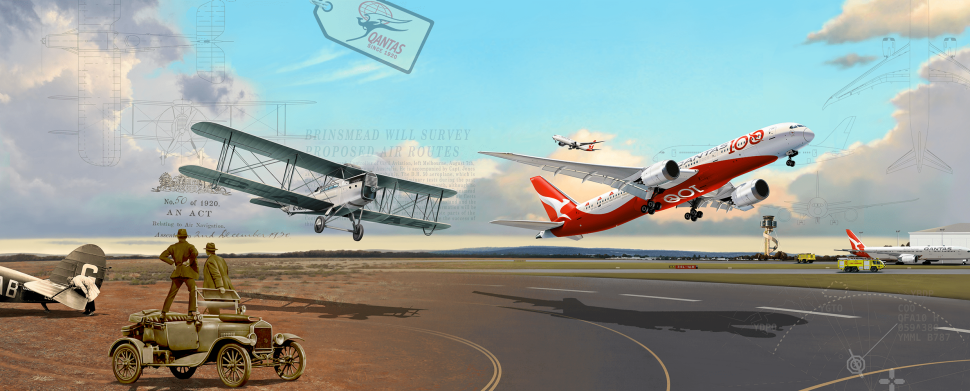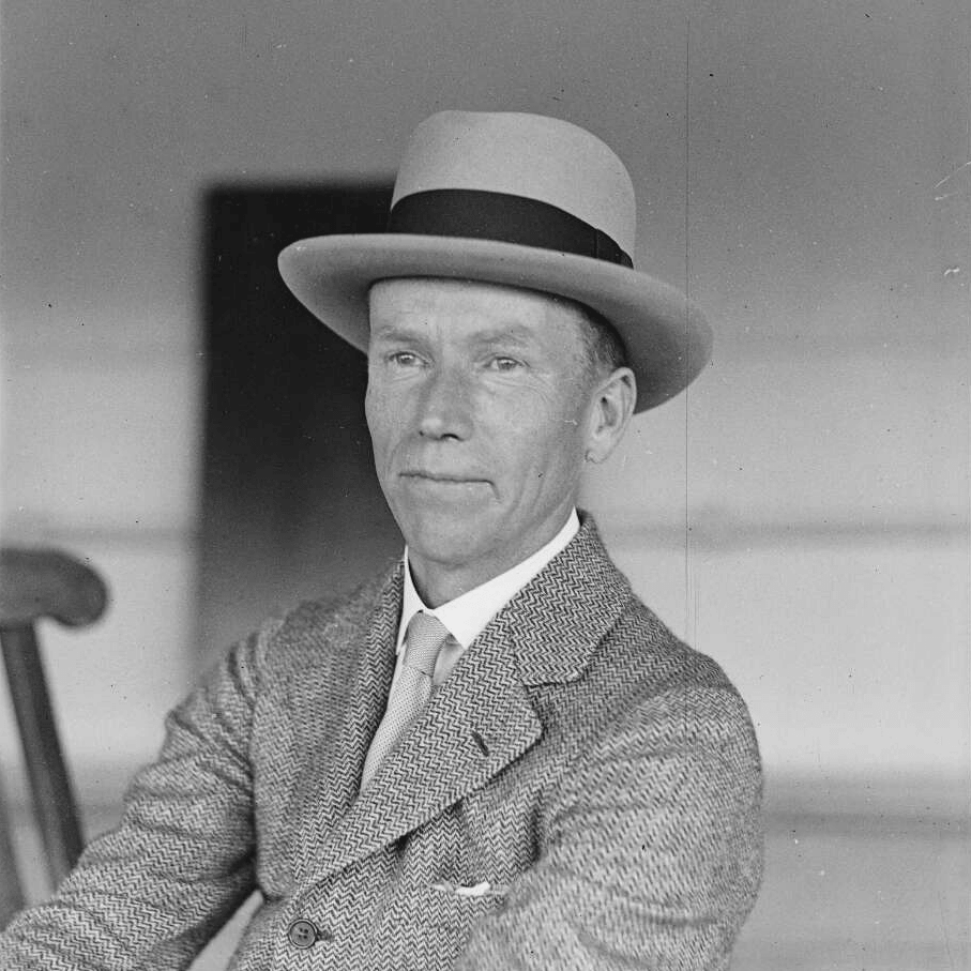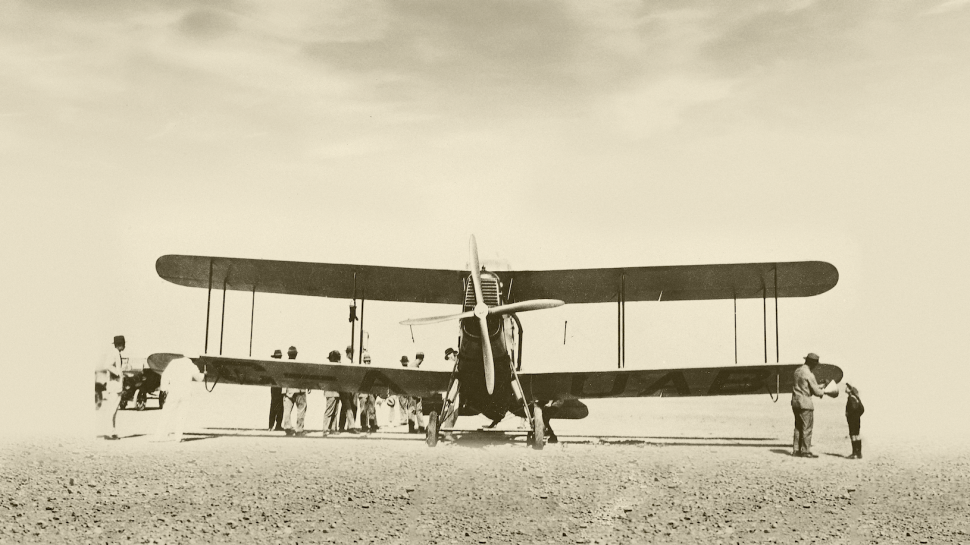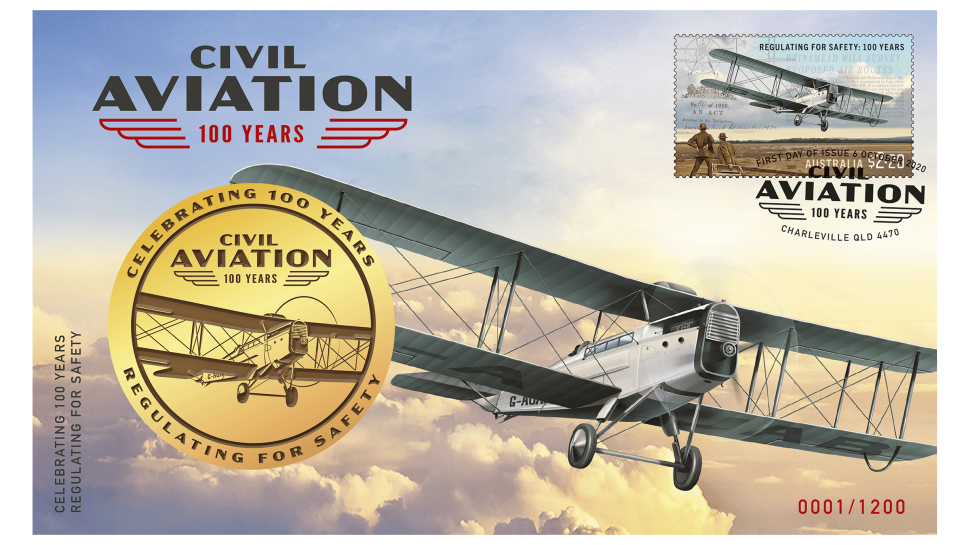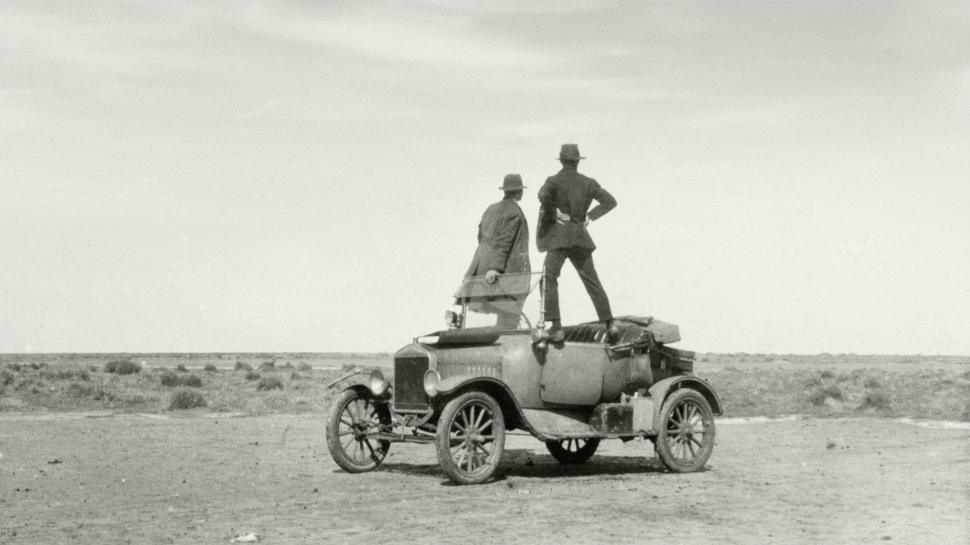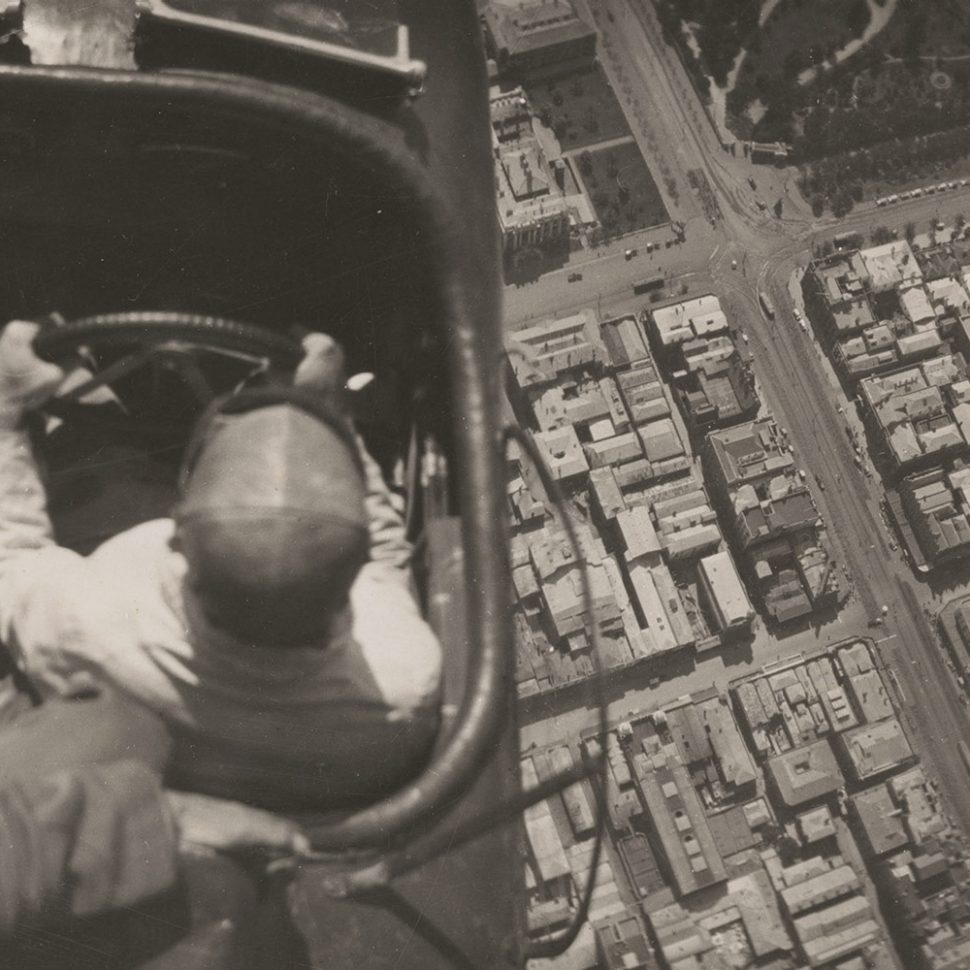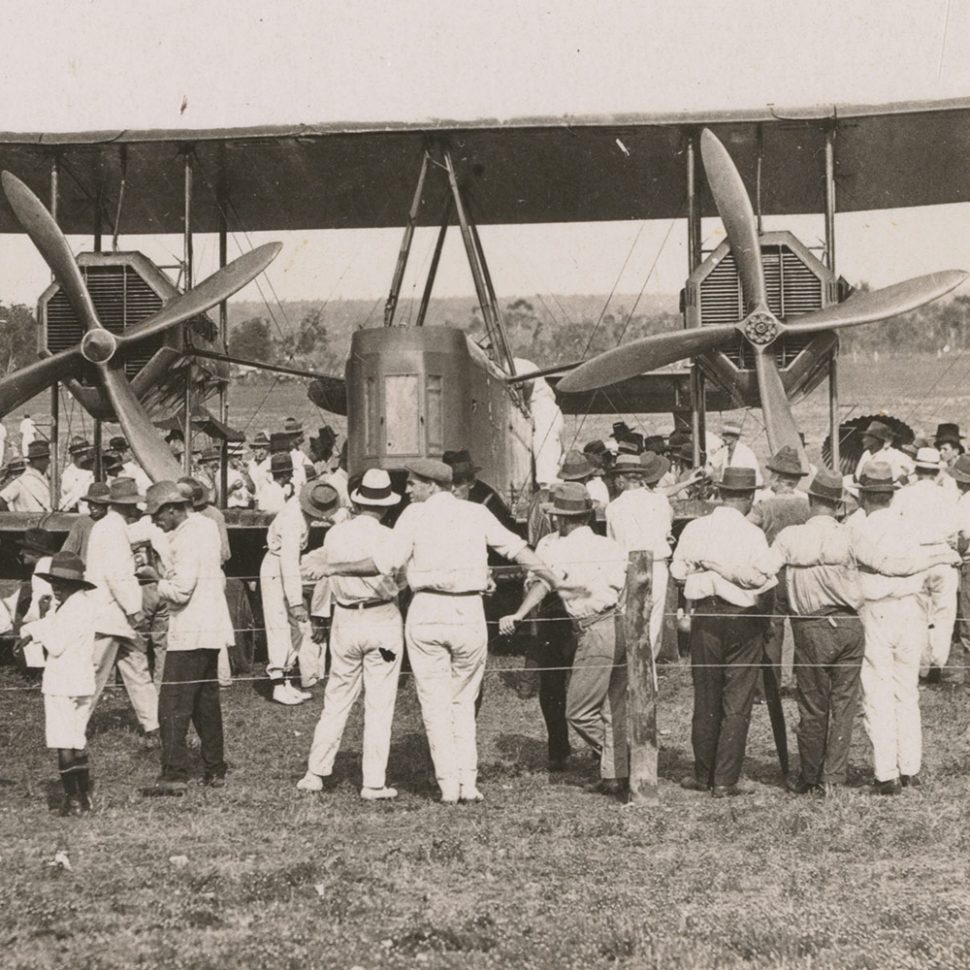The turn of the 20th century saw the first sustained and controlled flight in a motorised aeroplane, when brothers Orville and Wilbur Wright took to the air, in December 1903, in North Carolina, USA. It was an aeroplane made of spruce and muslin, powered by a small petrol-fuelled engine. The first flight in an Australian-made craft was by John Duigan, in 1910, at Mia Mia, in central Victoria.
World War I led to advances in aircraft engineering and design. The end of the war saw trained pilots return to Australia, keen to continue using their skills. Aircraft were also imported for civilian use, such as joy flights, demonstration flights and charter flights. At a political level, wartime prime minister William “Billy” Hughes became fascinated with aviation during this time. He had taken several flights, while in Europe for the Paris Peace Conference of 1919. Upon returning to Australia, he was keen to explore aviation’s possibilities, including whether it could help mitigate Australia’s “tyranny of distance”. His first initiative was the Great Air Race, which in December 1919 saw Captain Ross Smith and crew become the first airmen to complete a flight from England to Australia. This remarkable feat, the longest distance flown in the world at the time, was met with national and international acclaim.
Around this time, international aviation conventions were being developed and Britain passed its own civil aviation legislation. There was also concern about aviation fatalities in an unregulated environment. It was within this context that the Australian government made provision for the organisation and regulation of civil aviation in Australia, which began with the passing of the Air Navigation Act 1920 (which received royal assent on 2 December 1920).
The Civil Aviation: 100 Years stamp issue, which will be released on 6 October 2020, commemorates 100 years since the passing of this legislation. The stamps and minisheet scene paint a picture that spans the early days of regulated civil aviation in Australia, right up to the present-day and the centenary of Australia’s major national and international airline, Qantas.
In 1920, Lt Col. Horace C Brinsmead was appointed the inaugural Controller of Civil Aviation. He was a decorated veteran of Gallipoli and the Western Front and was tasked with drawing up regulations under the Act. Brinsmead was a respected administrator. In 1951, Qantas named its new L-749 Constellation aircraft after pioneers of Australian aviation; VH-EAF was named “Horace Brinsmead”.
When the Act came into force, on 28 March 1921, the Civil Aviation Branch (CAB) of the Department of Defence began operating. The many achievements of the CAB under Brinsmead included support for flying training, building safe infrastructure, and surveying landing grounds and airmail routes.
The $2.20 stamp presents an important flight of this early government era – the 1924 round-Australia survey flight by CAB officials, including Brinsmead, in the de Havilland D.H.50 G-AUAB (the third CAB aeroplane to be registered on the newly created aircraft register). The flight surveyed aerodromes and air routes between Darwin and Perth and Darwin and Melbourne, as well as testing the efficiency of the D.H.50 aircraft, which the government wished to use on its airmail routes that it had begun putting out to tender in 1921. In the background of the $2.20 stamp is a watermark of the cover page of the Air Navigation Act 1920, as well as text from a newspaper article about the CAB's 1924 survey flight.
A Regulating for Safety medallion cover, including the $2.20 stamp from this issue, will be released with this stamp issue. It contains a specially designed 60-milliimetre zinc alloy medallion with an antique gold plate finish. The design features the D.H.50 aircraft G-AUAB.
In the broader minisheet, an inspector is looking at an aircraft, while CAB officials look out at potential aerodrome locations (both of these components are based on real photographs). These two elements represent the significant efforts by early administrators to transform Australia into a safe and successful aviation environment.
The Act and its regulations established rules of the air. Systems were developed for aircraft registration, inspection and certificates of airworthiness, log books, lights and signals, and licensing of personnel. The government tenders to operate airmail routes assisted early airlines to become viable operations. In 1921, supported by subsidies from the CAB, Western Australian Airways began the first scheduled air service in Australia, between Geraldton and Derby, Western Australia.
Qantas also evolved in this way, operating a mail and passenger service between Charleville and Cloncurry, Queensland, from 1922. Queensland and Northern Territory Aerial Services Limited formed on 16 November 1920, founded by decorated World War I pilots Hudson Fysh and Paul McGinness, and businessman Fergus McMaster. Qantas is represented on the $1.10 stamp, to mark its centenary. Learn more about the history of Qantas.
Air traffic control in Australia’s major capital city airports began in the mid-1930s. By the late 1930s, it was compulsory for passenger aircraft to carry radio equipment. Ground stations were established, and radio navigation beacons installed. At first marine radio stations were used for communication with aircraft, but soon dedicated air traffic services were established. The importance of air traffic control in civil aviation safety is highlighted on the $1.10 stamp by the heritage-listed Sydney Airport air traffic control tower, as well as by the radar motif on the minisheet.
In 1938, the CAB became a government department in its own right, the Department of Civil Aviation, before amalgamating in 1973 with other government departments. Since 1995, the Civil Aviation Safety Authority has been the primary civil aviation safety regulator. Other government aviation bodies include the Australian Transport Safety Bureau, which investigates accidents and incidents, and Airservices Australia , which is the nation’s air traffic services provider and operates two major air traffic control centres in Melbourne and Brisbane, two terminal control units in Perth and Sydney, and 29 towers at international and regional airports. It also provides aviation rescue firefighting services at 27 of Australia’s busiest airports. Two aviation rescue firefighting trucks have been included in the stamp and minisheet scene.
Of great assistance to the philatelic researcher on this issue was Phil Vabre. Phil is an amateur aviation historian and Vice President of the Civil Aviation Historical Society & Airways Museum at Melbourne’s Essendon airport. By profession he is an Air Traffic Controller, with a background in aviation human factors and safety management. He is also a private pilot and owner/custodian of a venerable Cessna that, in his words, “is older than I am”.
We asked Phil to share some of his thoughts on civil aviation and the stamp issue.
- What lead to your interest in aviation?
When I was about 7 or 8, I complained to my mother that the books in the public library’s children’s section were all boring. She took me to the teenage section and pulled out a copy of Paul Brickhill’s biography of legless fighter pilot Douglas Bader, Reach for the Sky. I was hooked from that moment on!
- What do you believe is the legacy and significance of the early work done by Brinsmead and the CAB?
Australia has been – and is – second to none as an air-faring nation. As recent events have highlighted, we depend on aviation to connect us with each other and with the rest of the world. Everybody sees the aeroplanes, but few outside the industry know just what goes on behind the scenes to make sure that our aviation system operates reliably, safely and efficiently all day, every day of the year. All that is built on the foundation of the work done by Brinsmead and many, many others.
- What are some major developments in civil aviation in Australia have been key to maintaining a safe environment and to our reputation as a leader in safety?
Australia has always kept abreast of the latest technology and, as far as operating aircraft goes, in many cases has led the world. This has enabled us to develop and operate an aviation system whose safety is the envy of all. Improvements in safety are an incremental process, often informed by experience hard earned through tragedy. It is to our great credit as a nation that those lessons have been learned and translated into concrete improvements in everything from aircraft design and operation, to air traffic control and navigation, to weather forecasting, and a rigorous commitment to continuous improvement.
- Which of Australia’s aviation heroes of the past do you admire and why?
I’ve been fortunate to know a great many terrific people who have done extraordinary things in aviation, and to call many of them my friends. However, I think my real hero has to be Sir Gordon Taylor – a complex, demanding and flawed character, yet whose achievements and courage are unquestionable. He also wrote the most lyrical and beautiful books about flying that you will ever read.
- What are some of the key ways that civil aviation has impacted Australia?
Aviation impacts every aspect of life in Australia, whether it’s allowing us to connect with each other and the rest of the world or transporting the goods that make our lives what they are. Aviation has allowed us to build our nation and without it we would be much poorer, both financially and in spirit.
- How do you feel about civil aviation being highlighted in this stamp issue?
It’s very exciting, as civil aviation often takes a back seat to military aviation in the public imagination. It’s particularly great to see the work done in aviation by the various government agencies over the last century being honoured, as this story is at the core of the Civil Aviation Historical Society’s purpose.
The Civil Aviation: 100 Years stamp issue is available from 6 October 2020, online, at participating Post Offices and via mail order on 1800 331 794, while stocks last.
This content was produced at the time of the stamp issue release date and will not be updated.
This content was produced at the time of the stamp issue release date and will not be updated.
You might also like

